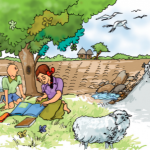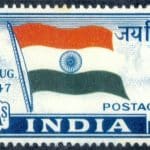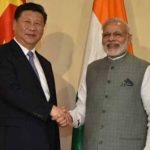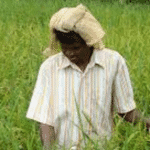Science Notes-Class 6 Chapter 8- Body Movements
- We are able to bend or rotate our body in places where two parts of our body seem to be joined together- like elbow, shoulder and neck. These places are called joints.
- Bones cannot be bent. We can bend or move our body only at those points where bones meet.
- There are different types of joints in our body.
- Ball and socket joints–
 the rounded end of one bone fits into the cavity (hollow space) of the other bone. Such a joint allows movement in all directions. For example, the joint between the shoulder and the arm.
the rounded end of one bone fits into the cavity (hollow space) of the other bone. Such a joint allows movement in all directions. For example, the joint between the shoulder and the arm.
2. Pivotal Joint-
The joint where our neck joins the head. It allows us to bend our head forward and backwards and to turn it to our left or right. In a pivotal joint, a cylindrical bone rotates in a ring.
3. Hinge Joints–
The elbow has a hinge joint that allows only a back and forth movement.
4. Fixed Joints–
Some joints between bones in our head do not allow the bones attached to move. Such joints are called fixed joints.There is a fixed joint between the upper jaw and the rest of the head.
- All the bones in our body form a framework to give a shape to our body. This framework is called the skeleton.
- Bones of the chest are called ribs. They join the chest bone and the backbone together to form a box called the rib cage. Some important internal parts of our body lie protected inside this cage.
- The backbone is made up of many small bones.
- The pelvic bones enclose the portion of our body below the stomach. This is the part we sit on.
- The skull is made up of many bones joined together. It encloses and protects the brain.
- There are some additional parts of the skeleton that are not as hard as the bones and which can be bent. These are called cartilage. It is present in the ear lobe. It is also found in the joints of the body.
- Muscles work in pairs. When one of them contracts, the bone is pulled in that direction. The other muscle of the pair relaxes. To move the bone in the opposite direction, the relaxed muscle contracts to pull the bone towards its original position, while the first relaxes.
- A muscle can only pull. It cannot push. Thus, two muscles have to work together to move a bone.
Earthworm
- Its body is made up of many rings joined end to end.
- It does not have bones.
- It has muscles which help to extend and shorten the body.
- Its body secretes a slimy substance to help the movement.
- Under its body, it has a large number of tiny bristles (hair-like structures) projecting out. They are connected with muscles and help to get a good grip on the ground.
Snail
- It carries a rounded structure on its back.
- This is called the shell and it is the outer skeleton of the snail but is not made of bones.
- It is a single unit and does not help in moving from place to place.
- It has to be dragged along.
- Snails move with the help of a muscular foot.
Cockroach
- They have three pairs of legs.
- The body is covered with a hard outer skeleton.
- This outer skeleton is made up of different units joined together and that permits movement.
- There are two pairs of wings attached to the breasts.
- They have distinct muscles- those near the legs move the legs for walking.
- The breast muscles move the wings when the cockroach flies.
Birds
- Strong muscles and light bones work together to help the birds fly.
- They fly by flapping their wings.
Fish
- The head and tail of the fish are smaller than the middle portion of the body- the body tapers at both ends. This body shape is called streamlined.
- The shape is such that water can flow around it easily and allow the fish to move in water.
Read More: Science Notes Class 6 Chapter 7











